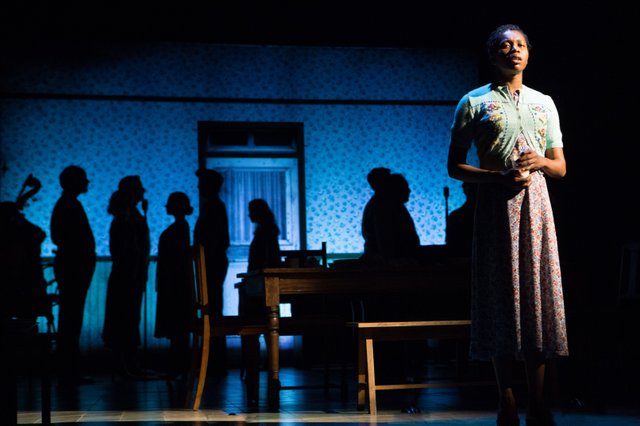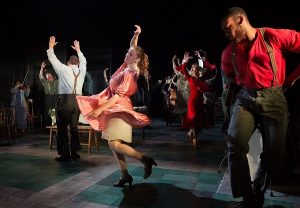About four years ago Connor McPherson, playwright of the successful play: The Weir, was asked if he would consider using the songs of Bob Dylan in a theatrical play. He dismissed the idea at first, thinking the songs lacked a certain theatricality. He didn’t think of Bob Dylan as a ‘musicals musician’. But after he thought about it for a while, he came up with an idea how to use the songs in a theatrical setting: the songs aren’t used as a narrative device or presented as actual songs. They’re used, as Connor describes it, ‘to create a conversation with the scenes’. They set the mood and express the emotions of the characters without having the text spell it out. After a successful run at the Old-Vic and a West End transfer the show opened Off-Broadway at the Public Theater last year. The show is currently playing in Toronto before returning to London and then going to Broadway.
Normally I would take some time here to explain the plot of the story, but this show does not have a conventional plot. Connor McPherson came up with characters and a setting, and most of the show’s story flows naturally from their interactions. The best way to describe it is as a mosaic, during the first act we see the stones and the pebbles from up close and during that act they start to move and clump together, in the second act they start to form a picture that only becomes completely clear at the end. You’ll gasp once you see the final image.

The play is set in a guesthouse in Duluth, Minnesota, which is Bob Dylan’s hometown. It is set during the Great Depression in 1934. Most, if not all characters are affected by the stock market crash and they have their own ways of coping. The primary characters in this play are Nick Laine, the owner of the guesthouse, his wife and his two children. Nick (Donald Sage MacKay) is trying dearly to get by with how many guests he has but he also has to take care of his wife Elizabeth Laine (Katie Brayben). Elizabeth’s mental state is deteriorating and it is becoming a burden on Nick. Her interactions are often comedic but can also turn very serious on a whim, once she gets her wits back. Nick’s son Gene (Colin Bates) wants to become a writer but for now is stuck in Duluth without luck, love, and a job, and thus he becomes an aimless alcoholic who is pressured by his father into finding a job. The fourth and final member of the family is Marianne. She is the adoptive daughter of Nick and Elizabeth, a black baby left in their guesthouse. Marianne (Gloria Obianyo) has gotten pregnant, but the father has run off, with no prospects for a fatherless baby Nick tries to marry her off to an old local shoe salesman with the inheritance in mind. Marianne doesn’t want to be sold off though. And then there are the guests in the guesthouse who further complicate the family relationships.
Unlike most other big musical productions where the elements of production are subservient to the story being told, here they work in tandem to create the best possible version of the story.

Something Connor McPherson as a director has done well in this production is to get all elements of production on the same line. Unlike most other big musical productions where the elements of production are subservient to the story being told, here they work in tandem to create the best possible version of the story. The set-design Rae Smith suggests the location by very literal elements such as chairs and some background screens that have pictures of walls and doors on them, but she abstracts these suggestions by occasionally having huge pictures of locations on the stage. The effect this creates is that the set is less a physical space and more the representation of a location. Rae also plays with the set-elements by using the screens that have images on them be see-through, multiple times in the show they are used to let light and shadow through. Though that could also be accredited to Mark Henderson’s incredible lighting design that creates moods to correspond with the music and the mood of the scene. Right when you walk into the theater is when you notice the lighting design, the stage is dimly lit except for the natural light of some room lamps. This already creates a particular mood, but then he breaks the scene by explicitly lighting one cello that’s centerstage. But the designer that, I think, had the most difficult job and therefore succeeded best out of all of them, is the orchestrator. Simon Hale had to fit these Bob Dylan songs into an era in which they weren’t written yet, using instruments that are specific to the era and he had to make them fit the mood of the scene in which they were used.

In conclusion, Connor McPherson took the challenge that Bob Dylan’s management presented him and succeeded wildly. He created a show wherein all elements of production form one hell of a show that will leave you trembling in your seat. The performances are stellar because the actors are portraying actors with very real stories and they’re lamenting those stories in hauntingly beautiful orchestrations of Bob Dylan’s songs. Expect this show to be a big contender come Tony season. I’m already looking forward to experiencing it again one day.
Seen on: 5/10/2019 seen at: the Royal Alexandra Theater, Toronto Canada. Writer & Director: Conor McPherson, Music & Lyrics: Bob Dylan, Scenic & Costume Design: Rae Smith Orchestrations, Arrangements, and Music Supervision: Simon Hale, Additional Arrangements: Simon Hale & Conor McPherson, Lighting Design: Mark Henderson, Sound Design: Simon Baker, Movement Direction: Lucy Hind.


